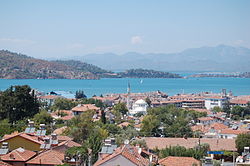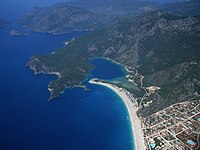| Revision as of 12:19, 11 April 2013 editMacrakis (talk | contribs)Autopatrolled, Extended confirmed users, Pending changes reviewers, Rollbackers53,866 edits restore source← Previous edit | Revision as of 12:27, 11 April 2013 edit undo81.213.109.191 (talk) typical greekficationNext edit → | ||
| Line 53: | Line 53: | ||
| ]]] | ]]] | ||
| '''Fethiye''' |
'''Fethiye''' is a ] and ] of ] in the ] ] of ] with about 68,000 ]s (2008). | ||
| ==History== | ==History== | ||
Revision as of 12:27, 11 April 2013
This article is about the city and district of Muğla Province. For other uses, see Fethiye (disambiguation). City in Aegean, Turkey| Fethiye | |
|---|---|
| City | |
 | |
 Location of Fethiye within Turkey. Location of Fethiye within Turkey. | |
| Country | |
| Region | Aegean |
| Province | Muğla |
| Government | |
| • Mayor | Behçet Saatçi (MHP) |
| Area | |
| • District | 2,955.08 km (1,140.96 sq mi) |
| Population | |
| • Urban | Template:Turkey district populations |
| • District | Template:Turkey district populations |
| Time zone | UTC+2 (EET) |
| • Summer (DST) | UTC+3 (EEST) |
| Postal code | 48x xx |
| Area code | 00 (90) 252 |
| Licence plate | 48 |
| Website | www.fethiye.bel.tr |

Fethiye is a city and district of Muğla Province in the Aegean region of Turkey with about 68,000 inhabitants (2008).
History
Modern Fethiye is located on the site of the ancient city of Telmessos, the ruins of which can be seen in the city, e.g. the Hellenistic theatre by the main quay.
Telmessos was the most important city of Lycia, with a recorded history starting in the 5th century BC.
A Lycian legend explains the source of the name Telmessos as follows: The god Apollo falls in love with the youngest daughter of the King of Phoenicia, Agenor. He disguises himself as a small dog and thus gains the love of the shy, withdrawn daughter. After he reappears as a handsome man, they have a son, whom they name 'Telmessos' (the land of lights). The city became part of the Persian Empire after the invasion of the Persian general Harpagos in 547 BC, along with other Lycian and Carian cities. Telmessos then joined the Attic-Delos Union established in mid-5th century BC. and, although it later left the union and became an independent city, continued its relations with the union until the 4th century BC.
The oracle of Telmessos, devoted to Apollo, had great impact on the course of ancient history.
Legend says that Alexander the Great, on a mission to invade Anatolia in the winter of 334–333 BC, entered Telmessos harbour with his fleet. The commander of the fleet, Nearchus, asks permission of King Antipatrides of Telmessos for his musicians and slaves to enter the city. On getting the permission, the warriors with weapons hidden in the flute boxes capture the acropolis during the feasts held at night.
Very little is known of the city during Byzantine times. Surviving buildings attest to considerable prosperity during late Antiquity, but most were abandoned in the 7th–8th centuries due to the Arab-Byzantine Wars. The city was fortified in the 8th century, and appears as "Telmissos or Anastasioupolis" ca. 800. By the 10th century, the ancient name was forgotten and it became known as Makre or Makri (Μάκρη, "long one"), from the name of the island at the entrance to the harbour. In the 12th–13th centuries there are signs of renewed prosperity: the city walls were enlarged, a report from 1106 names Makre a centre for perfume production, and geographical works from the 13th century describe the city as a commercial centre. The area fell to the Turks in the late 12th or early 13th century.
Telmessos was ruled by the Anatolian beylik of Menteşe starting in 1284, under the name Megri. It became part of the Ottoman Empire in 1424.
The town grew considerably in the 19th century, and had a large Greek population at this time. Following the population exchange between Greece and Turkey, the Greeks of Makri were sent to Greece where they founded the town of Nea Makri (New Makri) in Greece. The town was resettled with Turks from Greece.
In 1934, the city was renamed 'Fethiye' in honor of Fethi Bey, one of the first pilots of the Ottoman Air Force, killed on an early mission.
Fethiye has experienced many earthquakes. Last significant ones date to 1957 and 1961, with 67 casualties and 3200 damaged buildings after the 25.04.1957 earthquake. The town has been rebuilt since then and now has a modern harbor and a marina.
Tourism

Fethiye is one of Turkey's well-known tourist centres and is especially popular during the summer.
In the last ten years Fethiye has become a magnet for British citizens. Apart from its climate and natural beauty, the Britons are attracted by its less expensive lifestyle and the hospitality of the local people. The British population in Turkey is between 34,000 and 38,000. As a result of the large British population and the high numbers of Britons going there for holiday, Fethiye-Öludeniz was chosen as the best tourism centre in the world by The Times and The Guardian newspapers in 2007. Over 7,000 British citizens permanently live in Fethiye, while approximately 600,000 British tourists visit the town every summer.
The Fethiye Museum, which is very rich in ancient and more recent artifacts, displays and testifies to the successive chain of civilizations that existed in the area, starting with the ancient Lycians.
Fethiye is also home to the Tomb of Amyntas, a large and beautiful tomb built in 350 BC by the Lycians. What makes this tomb very unique is its massive size and beautiful carvings.
Climate
Fethiye has a Mediterranean climate consisting of very hot, long and dry summers with an average of 34°C (93°F) in the daytime, winters are cool and rainy with a daytime average of 16°C (61°F).
| Climate data for Fethiye | |||||||||||||
|---|---|---|---|---|---|---|---|---|---|---|---|---|---|
| Month | Jan | Feb | Mar | Apr | May | Jun | Jul | Aug | Sep | Oct | Nov | Dec | Year |
| Mean daily maximum °C (°F) | 16.0 (60.8) |
16.3 (61.3) |
18.9 (66.0) |
22.0 (71.6) |
26.4 (79.5) |
31.4 (88.5) |
34.3 (93.7) |
34.4 (93.9) |
31.3 (88.3) |
26.5 (79.7) |
21.1 (70.0) |
17.2 (63.0) |
24.7 (76.4) |
| Mean daily minimum °C (°F) | 5.3 (41.5) |
5.7 (42.3) |
7.2 (45.0) |
10.1 (50.2) |
13.8 (56.8) |
17.6 (63.7) |
20.3 (68.5) |
20.2 (68.4) |
16.9 (62.4) |
13.1 (55.6) |
9.1 (48.4) |
6.6 (43.9) |
12.2 (53.9) |
| Average precipitation mm (inches) | 159.8 (6.29) |
128.4 (5.06) |
80.1 (3.15) |
49.0 (1.93) |
25.8 (1.02) |
4.8 (0.19) |
3.1 (0.12) |
2.6 (0.10) |
17.6 (0.69) |
66.7 (2.63) |
123.3 (4.85) |
174.1 (6.85) |
835.3 (32.88) |
| Average rainy days | 12.1 | 11.3 | 9.0 | 8.0 | 4.4 | 2.2 | 1.4 | 1.6 | 2.5 | 5.7 | 8.3 | 12.1 | 78.6 |
| Mean monthly sunshine hours | 145.7 | 156.8 | 213.9 | 237 | 300.7 | 342 | 359.6 | 344.1 | 294 | 244.9 | 165 | 127.1 | 2,930.8 |
| Source: Devlet Meteoroloji İşleri Genel Müdürlüğü | |||||||||||||
The airport that serves Fethiye areas is called DALAMAN AIRPORT.
See also
- Turkish Riviera
- Marinas in Turkey
- Foreign purchases of real estate in Turkey
- Göcek
- Ölüdeniz
- Lycia
- Tomb of Amyntas
References
- "Area of regions (including lakes), km²". Regional Statistics Database. Turkish Statistical Institute. 2002. Retrieved 2013-03-05.
- Foss " first1 = Clive; Kazhdan, Alexander P. (1991). "Makre". In Kazhdan, Alexander P. (ed.). Oxford Dictionary of Byzantium. New York; Oxford: Oxford University Press. pp. 1271–1272. ISBN 978-0-19-504652-6.
{{cite encyclopedia}}: Missing pipe in:|last1=(help)CS1 maint: numeric names: authors list (link) - ^ Cite error: The named reference
Darkewas invoked but never defined (see the help page). - "Significant Earthquakes in Turkey, 1947 – 1970". Boğaziçi University, Kandilli Observatory and Earthquake Research Center, Istanbul – Turkey. Retrieved 2011-02-25.
- Berens, Kallie. "Fethiye Tomb in the Mountainside". Mysendoff.com Website. mysendoff.com. Retrieved 19 October 2011.
- İl ve İlçelerimize Ait İstatistiki Veriler- Meteoroloji Genel Müdürlüğü. Dmi.gov.tr. Retrieved on 2011-04-16.
| Neighbourhoods of Fethiye District | |
|---|---|
|
| Fethiye in Muğla Province of Turkey | ||
|---|---|---|
| Districts |  | |
| Metropolitan municipalities are bolded. | ||
